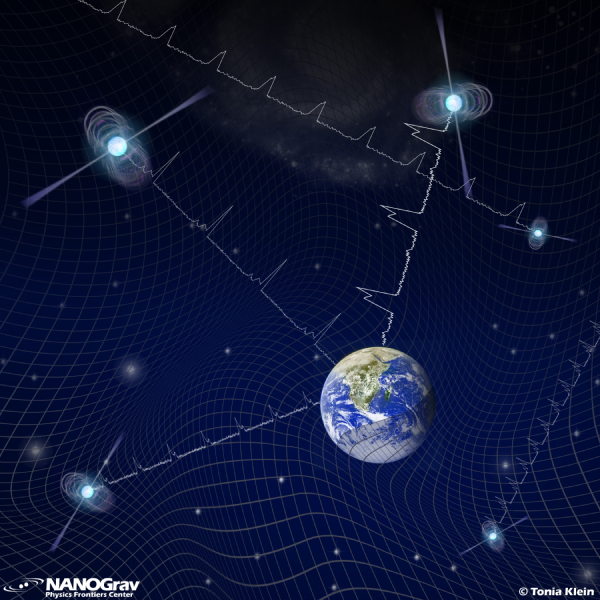
The National Science Foundation has renewed its support of the North American Nanohertz Observatory for Gravitational Waves Physics Frontiers Center—a collaboration of scientists working to detect and study very low frequency gravitational waves—with a five-year, $17 million grant. The Vanderbilt node of the NANOGrav NSF Physics Frontier Center is led by Stephen R. Taylor, assistant professor of physics and astronomy.
The funding will directly support the work of Taylor and his group of Ph.D. students and postdoctoral scholars as they lead the development of new methods and techniques to search for the elusive signature of the gravitational wave background, individual gravitational wave signals, and other exotic phenomena.
NANOGrav researchers at Vanderbilt also include Assistant Professor of Astronomy and Physics Jessie Runnoe, postdoctoral fellows Nihan Pol and Maria Charisi, graduate students William Lamb and Natasha McMann, and undergraduate researchers Qiaohong Wang, Katharine Cella and Alexander Douglas.

“It’s an enormously exciting time to be in this field and at the frontier of the next big breakthrough in gravitational wave astronomy,” Taylor said. “This NSF funding over the next five years and my group’s work at Vanderbilt will allow us to mine a huge amount of astrophysical information from our datasets, which are constantly being improved. It’s highly likely that our big breakthrough detection is just around the corner.”
According to a release, NANOGrav’s low-frequency gravitational-wave detectors are millisecond pulsars—rapidly spinning, superdense remains of massive stars that have exploded as supernovas. These ultra-stable stars are nature’s most precise celestial clocks, appearing to “tick” every time their beamed emissions sweep past the Earth, like the beacon on a lighthouse. Small but perceptible fluctuations in the Earth arrival times of these radio pulses—measured in mere nanoseconds over 10 or more years—allow scientists to detect the gravitational waves.
“The NANOGrav PFC has made significant progress over the last five years, remaining at the frontier of fundamental physics research,” said Jim Shank, the program director for NSF’s Physics Frontiers Center program. “The center now seems close to making a breakthrough discovery in gravitational waves and the way we perceive the universe.”
NSF currently supports 11 PFCs ranging in research areas from theoretical biological physics and the physics of living cells to quantum information and nuclear astrophysics. By bringing together astronomers and physicists from across the United States and Canada to search for the telltale signature of gravitational waves buried in the incredibly steady ticking of distant pulsars, the NANOGrav PFC will advance the mission to “foster research at the intellectual frontiers of physics” and to “enable transformational advances in the most promising research areas.”
NANOGrav’s five-year program will make use of the unique capabilities and sensitivity of the Green Bank Telescope in Green Bank, West Virginia. The GBT is located in the National Radio Quiet Zone, which protects the incredibly sensitive telescope from unwanted radio interference, enabling it to study pulsars and other astronomical objects. It also uses data from the Very Large Array in New Mexico and the Canadian Hydrogen Intensity Mapping Experiment. In addition, NANOGrav will use legacy Arecibo Observatory data which will anchor combined future datasets. The GBT, VLA and Arecibo are all funded by the National Science Foundation. NANOGrav is also a member of the International Pulsar Timing Array collaboration, which aims to combine data from telescopes in North America, Europe, South Africa, India and China to form the most sensitive pulsar-timing dataset in the world.
Taylor is the co-chair of NANOGrav’s Detection Working Group, a member of NANOGrav’s management team and NANOGrav’s representative to the International Pulsar Timing Array Steering Committee.